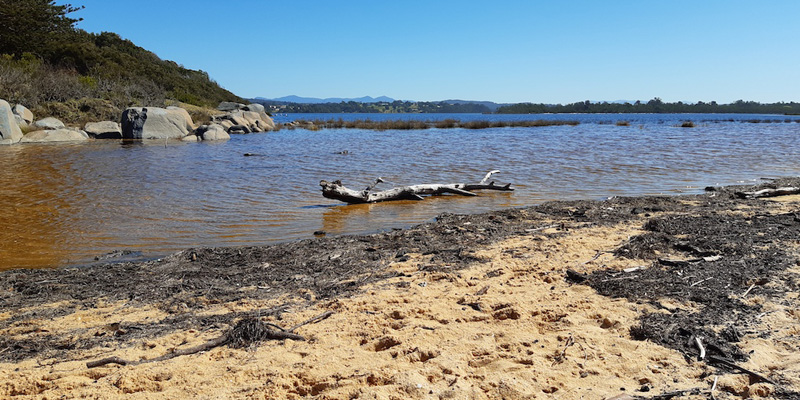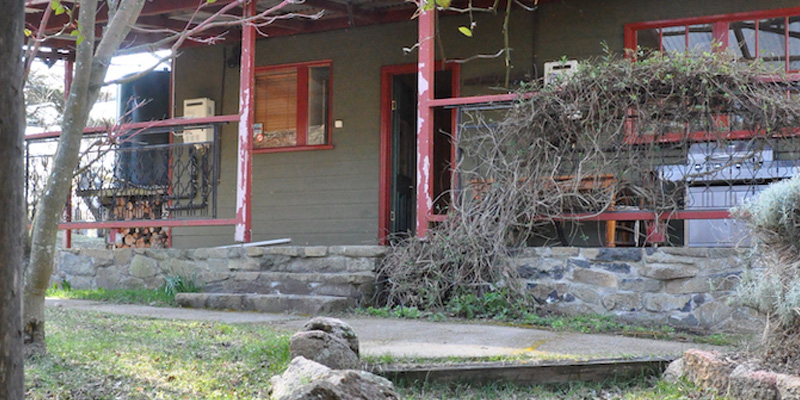Day 1: Tuross Head
A landscape painter’s paradise
Along the beach, washed-up driftwood records the tidemarks in scraggly arcs.
Some is regulation sun-bleached grey, but some is still blackened – a remnant of the catastrophic bushfires that hit the NSW south coast in early 2020. The sea might have no memory, but the shoreline remembers all. The scene is hopeful though, in an odd way.
While nature discards its charred memories on the cove’s crusted sands, locals have made little huts out of the unburnt driftwood, as if to signify a rebuilding process. Standing on the shores of Coila Lake, I once again admire its breeze-rippled waters deepening from tea-coloured shallows to indigo depths.

A squadron of pelicans off to the left discusses the day’s catch.
In the foreground, ancient volcanic rocks protrude from the earth, while front and centre rests a large piece of weathered driftwood. Mountain ranges in the distance cut a jagged purple horizon across the cloudless sky.
No matter where you venture around Tuross Head, there seems to be similar visual richness. It’s a landscape painter’s paradise.
Stop 1: Take a walk along Tuross Boulevarde
If you only have an hour or two to spare, start at Coila Bar Beach and follow Tuross Boulevarde on its course around the head.
It passes several points of interest, including a war memorial, the aptly named One Tree Point (which also offers fine views across the southern end of town) and a whale burial site.
The unfortunate mammal washed up in 1980 and, rather than blow it up, the local council buried it in nearby McWilliam Park where it now forms a grassy mound beside the water.
The site can be somewhat tricky to spot while driving but you’ll find it opposite 25 Tuross Boulevarde.

Day 2: Tuross to Tilba
Next stop: Calf feeding at Bodalla Dairy
Tourism isn’t a vocation for the easily discouraged and those with a natural affinity for it seem to thrive in adversity. Sandra McCuaig at Bodalla Dairy is a prime example. During lockdowns, Sandra set about repurposing the dairy’s largely unused courtyard areas to accommodate patrons.
The outdoor settings have quickly become more popular than those indoors, which is clearly the case on this particular morning. Daily calf feeding at 10am and 4pm is an irresistible family attraction and occurs all year round.
Sandra buys calves at bottle-feeding age and then sells them on when they get older before acquiring another pair. Bodalla Dairy never stands still with its ice cream, either, and is a regular finalist in national competitions.
It experiments with unusual ingredients and methods. On the menu during our visit is smoked macadamia and we’re sceptical of its merits, but the distinctive smoky flavour complements the ice cream’s sweetness.

Stop 2: Southwards to Tilba Valley Winery
About a half-hour drive south, the Tilba Valley Winery and Ale House is well worth a visit, especially when it’s paired with such a gloriously sunny day.
Google Maps sends us on a dirt access road that seems quicker than the usual signposted route, but it could have been much slower going if we weren’t in a 4x4 Ford Everest to traverse its foot-deep rills.
Siblings Carly, Jaime and Chloe Smith took over the old winery a few years ago and ushered it into the 21st century. They added the eponymous ale, a lunch menu, live music every weekend, and a sandpit for the kids.
Set on a bushy hilltop overlooking a valley and pond, it’s also in demand as a wedding venue. We do wine tasting for a gold coin donation and walk out with a cabernet sauvignon, pinot and a tawny port, then settle in under the trees for some lunch.
With full bellies, sun on our faces and a gentle breeze caressing our skin, we’re regretful indeed that we have to move on.

Stop 3: Some retail therapy at Central Tilba
But Central Tilba, with its country-style retail therapy, softens the blow. We kick off at the bottom of the hill with the ABC Cheese Factory and work our way up through shops filled with clothing, jewellery, bath bombs, woodwork, lollies, tea, leather goods and more.
Even the kids enjoy it, which is a far cry from my wife’s childhood Tilba memory of waiting an eternity for a pie that turned out to be frozen in the centre.
Against the odds we pull off a “come back here one day” quinella when we head for the coast and cross the bridge into Bermagui.
This time the delay is only two years and I have some unfinished business with the Blue Pool, which in the 1930s was built into rockpools at the bottom of a cliff. Last time, I tried unsuccessfully to photograph it amid afternoon shadows and now the morning sun illuminates it to its best effect.
In fact, ‘Bermi’ bristles with photo opportunities. While Camel Rock should be renamed ‘Headless Camel Rock’ for accuracy, its craggy hide makes a striking beachfront silhouette.
Also worth checking out is Horse Head Rock, although to reach that you need to brave some rough terrain and keep an eye on the tide.
With a sleep-deprived four-year-old among our tribe and a strong southerly blowing up the coast, we settle for a headless camel photo and seek out more clement activities.

Stop 5: A visit to Bermagui Mudworks
The wife’s online meanderings unearth a pottery barn, and to say I’m enthusiastic about this turn of events would be a lie of saurian proportions. Yet when we leave Bermagui Mudworks nearly two hours later it’s with great reluctance and a boxload of earthenware.
Mike and Kim Collingham are husband and wife potters who created this little artistic paradise that sits on the fringe of Bermagui’s industrial area.
Our following dining experience is lunch at the Sun Deck Café overlooking Bermagui Wharf, before heading downstairs for some fancy-pants ice cream at The Gelato Clinic.
We round out the afternoon at Horseshoe Bay, where Kellie and the kids collect shells on the sand while I read about the remnant piles from the old steamer wharf, which made Bermagui a hub of industry as late as the 1950s.

Day 3 - Cobargo and Nimmitable
Stop 1: Inland to Cobargo and Nimmitable
Next day we turn inland and make a brief stop at Cobargo. Bookshops are my catnip and I exit Well Thumbed Books with Dickens’ Hard Times and Twain’s Life on the Mississippi under my arm.
We continue along the Snowy Mountains Highway towards Nimmitabel, an Aboriginal word that means ‘place where many waters start or divide’.
Nimmitabel is best known in modern times for its old mill, bakery and George the stonework elephant (erected only in 1999 but strangely no one seems to remember who did so or why).
The mill was a three-year project in the 1860s for German settler John Geldmacher, who planned it as a windmill until council told him he couldn’t erect the sails because the mill was close to the road and the noise would frighten passing horses.
Geldmacher’s windmill became a horse-driven one instead and these days it’s a Nimmitabel icon.

Stop 2: A pub meal at the Federal Hotel
That evening we sit down to a pub meal at the Federal Hotel, which was built back in 1890. Nimmitabel was once a major waystation along the Monaro Highway and the pub has led a storied life.
Of particular note is the musical talent to which it has played host – everyone from Peter Garrett to Suzi Quatro.
A man the locals call ‘Tooth’ sits at the table near us weaving scarves. We get talking and he regales my kids with all five stanzas of Banjo Paterson’s ‘Mulga Bill’s Bicycle’, which he recites from memory.
These are the experiences you only get in the country on a cold, quiet night.

Day 4: Along the Snowy Mountains Highway to Braidwood
Exploring the Snowy Hydro story
The Snowy Mountains Highway delivers one of the most striking drives in Australia, and that’s especially true of the section between Nimmitabel and Cooma.
The Snowy region can make for a stark landscape even in fertile times, but at the tail-end of a long drought the vista could be a Martian plain.
The road is scant of traffic and we arrive safely at the Snowy Hydro, arguably the most important feat of engineering in Australia’s history. It put Australia on the map as a forward-thinking nation, it helped reshape our cultural fabric for decades to come.
Many of the migrants who came to work on the Snowy Mountains Scheme put down roots and raised families. Its interesting, illustrious and unexpectedly moving history can now be viewed in a new theatrette at the Snowy Hydro, particularly appealing to kids.
Stop 2: Cooma from Mount Gladstone Lookout
Cooma is often a stop on the way to somewhere else, but it’s worth exploring as a destination.
The town’s once-unthinkable gentrification continues apace, with cafés, restaurants and galleries opening up everywhere. Plus, if you know where to go, Cooma and its surrounds have stunning lookouts.
Nanny Goat Hill is more or less in the centre of Cooma and gives a bird’s-eye view over the town. A short drive outside Cooma is Mount Gladstone Lookout, which provides an epic vista in all directions, including back towards Cooma itself.

Stop 3: Lunch at Braidwood
Situated midway between Canberra and Batemans Bay, Braidwood is a town Sydneysiders have to visit on purpose – it’s not really ‘on the way’ to anywhere.
But visit they do and we’re the latest to take in its main street with well-preserved historic buildings and interesting array of shops.
We have lunch at the Albion Café and it’s the gastronomic pinnacle of our trip – the best coffee I’ve had all week, French toast with presentation only outdone by its taste, a scrumptious take on classic smashed avo, and a moreish bowl of chips for the kids.
Stop 4: Saddle camp a holiday highlight
Holidays are a good opportunity to try something different and on our final night that something is our accommodation.
It’s a tiny house erected in a paddock of Saddle Camp, about 15 minutes west of Braidwood, which specialises in horse riding experiences for kids.
Owner Helen Faulkner invested in tiny houses to attract some extra income. Upstairs (though it’s more like ‘upladder’) is a loft with a queen bed and below is a lounge with a fold-out bed, compact shower, toilet and kitchen.
But the glass walls and wraparound deck really sell it, especially when matched with a glass of wine on a lazy afternoon.
When the sun’s up and we’ve had breakfast and packed the car, we wander up to the stables and Helen takes the girls on their first horse ride.
After some initial nerves, Chloe and Cody get into it and by the end they’ve declared the guided trail ride their holiday highlight.

Day 5: Homebound
When the sun’s up and we’ve had breakfast and packed the car, we wander up to the stables and Helen takes the girls on their first horse ride. After some initial nerves, Chloe and Cody get into it and by the end they’ve declared the guided trail ride their holiday highlight.
We have two options in heading home from Braidwood.
The longer route via Nerriga and Braidwood Road spears through some dense bushland and passes the beautiful Tianjara Falls, before popping out just north of Bewong on the Princes Highway.
The alternative is to head north out of Braidwood on Goulburn Road and along the stretch between Tarago and Goulburn. Either way, the scenery is a fitting end to one of the most picturesque and entertaining routes our state has to offer.


























